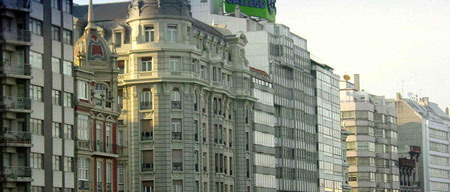Home > Study in Spain > City Guide > A Coruña
A Coruña City Guide
- Places of Interest
- Maps
- Getting to
- Getting around the city
A Coruña is Galicia's wealthiest, and until recently, largest city, as well as being the most open-minded and cosmopolitan, probably due to its 2000-year old status as a sea port and its current position as centre of Galician and national industry and commerce. Although no longer the capital of the region, after this accolade was handed over to Santiago de Compostela in the 1980s, A Coruña still holds a certain status in Galicia, and is particularly famous for being the home of the second largest textile company in the world, Inditex, the company responsible for the most famous Spanish names on high streets the world over, such as Zara, Pull&Bear, Bershka, Massimo Dutti, and many, many more.
Although A Coruña is a city which largely came to life in the 19th and 20th centuries, the city does have an interesting history, especially connected with the British. In 1588, the Spanish Armada anchored there, and in the following year Sir Francis Drake tried to capture the town, although unsuccessfully. Napoleon had troops in A Coruña for the first six months of 1809, and although their British opponents were eventually able to evacuate, their commander, General Sir John Moore, died in battle and was buried in the town. A Coruña became important in the 19th and 20th centuries as a gateway to the Americas for people who wanted to leave Spain to start new lives there.
A Coruña is a unique place, unlike anywhere else in Spain. Come and discover this fascinating port town, so important for understanding the intriguing region of Galicia; we know you'll fall in love from the first day.
Places of Interest
Paseo Marítimo
This skirts the entire city, and is the longest promenade in Europe. By following this promenade, you can pass most of A Coruña's main sights, such as the Castle of San Antón or the Tower of Hercules.
Playas de Orzán and Riazor
These are the two main beaches in A Coruña, and they are located in the heart of the city, and bordered by the promenade above. Many surfers flock to these beaches to make the most of the huge waves.
Tower of Hercules
This is a lighthouse that has been in operation for nearly 2000 years. It has been declared by UNESCO as Human Heritage.
Plaza de María Pita
This atmospheric plaza is named after María Pita, the heroine who defended A Coruña against Francis Drake's troops and held them off. It is the centre of life in A Coruña, and particularly busy at weekends. This is where the impressive-looking town hall is situated.
Castillo San Antón
This fortress, which dates back to somewhere between the 16th and 18th centuries, provides magnificent views of the city. Originally built to protect the city from sea attacks, it now acts as the headquarters of the city's Museo Arqueológico e Histórico, where you can see artefacts from Galicia's history, in particular, an impressive gold and silverwork collection.
Parque Municipal de Monte de San Pedro
This old military base is one of the most beautiful places in A Coruña, and undoubtedly the place with the best views of the city and the coastline. The park has facilities such as a café and a restaurant, where you can enjoy the views in comfort, a children's zone, and even a maze! Perfect for taking a walk or for simply relaxing and taking in the breathtaking surroundings.
Aquarium Finisterrae
Created by the town council of A Coruña, this aquarium promotes education about marine life, particularly that of the marine life found around the coast of Galicia, in an attempt to encourage positive attitudes towards environmental conservation. As well as fish tanks, this aquarium has interactive exhibits for learning and enjoyment. Entrance is 10€, 4€ concessions.
Maps
Getting to A Coruña
By Air
8km outside of the city there is A Coruña airport, with direct flights to Madrid, Barcelona, Bilbao, Seville, Lisbon, Amsterdam, London Heathrow and Huesca. There is a bus that runs every 30 minutes (every 60 minutes at weekends) to take you to the city centre that takes about 25 minutes and costs 1.25€. 60km away is Santiago airport, which has many more flights than A Coruña. Autocares Travidi connect Santiago airport with A Coruña.
By Train
There is a RENFE station in A Coruña, with services to Madrid, Barcelona and Bilbao-Irún, as well as regional services to Santiago, Vigo, Ferrol and Monforte.
By Bus
From the bus station in A Coruña, there are 16 buses daily to Santiago and 6 daily buses to Pontevedra and to Vigo. There are also several buses a day to Betanzos, Ferrol, Viveiro, Lugo, Ourense and the Costa da Morte. ALSA runs buses for further distances, to destinations such as Asturias, Cantabria, the Basque Country, Barcelona, Madrid, Portugal, Andalucía and Extremadura.
By Boat
There is a port at A Coruña, which is linked up with a variety of destinations all over the world.
Getting around the city
There is a bus system in place in A Coruña, one ride costs 1.15€. Daily from mid-June to October, and at weekends the rest of the year, trams run along the Paseo Marítimo from the port area all the way around the headland towards the city centre and the Playa de Riazor. Rides cost 1€.
Tips
If you are a fan of tapas, make sure you visit La Bombilla on Calle de la Galera, which is said to have the best tapas in A Coruña, and only costs 1€ per dish.

